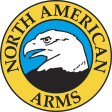
A revolver is a repeating handgun that has at least one barrel and uses a revolving cylinder containing multiple chambers for firing. Because most revolver models hold up to six cartridges, before needing to be reloaded, revolvers are commonly called six shooters.

Smith & Wesson Brands, Inc. (S&W) is an American firearm manufacturer headquartered in Maryville, Tennessee, United States.

Colt's Manufacturing Company, LLC is an American firearms manufacturer, founded in 1855 by Samuel Colt and now a subsidiary of Czech holding company Colt CZ Group. It is the successor corporation to Colt's earlier firearms-making efforts, which started in 1836. Colt is known for the engineering, production, and marketing of firearms, most especially between the 1850s and World War I, when it was a dominating force in its industry and a seminal influence on manufacturing technology. Colt's earliest designs played a major role in the popularization of the revolver and the shift away from single-shot pistols. Although Samuel Colt did not invent the revolver concept, his designs resulted in the first very successful model.

The Webley Revolver was, in various designations, a standard issue service pistol for the armed forces of the United Kingdom, and countries of the British Empire and the Commonwealth of Nations, from 1887 to 1970.

Webley & Scott is an arms manufacturer founded in Birmingham, England. Webley produced handguns and long guns from 1834 to 1979, when the company ceased to manufacture firearms and instead turned its attention to producing air pistols and air rifles. In 2010 Webley & Scott restarted the production of shotguns for commercial sale.

The .32 S&W Long, also known as 7.65x23mm, is a straight-walled, centerfire, rimmed handgun cartridge, based on the earlier .32 S&W cartridge. It was introduced in 1896 for Smith & Wesson's first-model Hand Ejector revolver. Colt called it the .32 Colt New Police in revolvers it made chambered for the cartridge.

An automatic revolver also known as semi-automatic revolver, is a revolver that uses the recoil energy of firing for cocking the hammer and revolving the cylinder, rather than using manual operations to perform these actions. As semi-automatic firearms, the shooter must manually operate the trigger to discharge each shot.

William Mason was a patternmaker, engineer and inventor who worked for Remington Arms, Colt's Patent Fire Arms Manufacturing Company, and Winchester Repeating Arms Company in the 19th century.

The Webley–Fosbery Self-Cocking Automatic Revolver is a recoil-operated automatic revolver designed by Lieutenant Colonel George Vincent Fosbery VC and produced by the Webley & Scott company from 1901 to 1924. The revolver is easily recognisable by the zig-zag grooves on the cylinder.

H&R 1871, LLC, or more commonly known as Harrington & Richardson, is an American brand of firearms and a subsidiary of JJE Capital Holdings. H&R ceased independent production February 27, 2015.

In American English, a pocket pistol is any small, pocket-sized semi-automatic pistol, and is suitable for concealed carry in a pocket or similar space.

North American Arms is a United States company, headquartered in Provo, Utah, that manufactures pocket pistols and mini-revolvers, also called mouse guns. The company was originally named Rocky Mountain Arms when it was founded in 1972. In 1974 it was bought by new owners who renamed the company North American Manufacturing (NAM) and then North American Arms (NAA).

Iver Johnson was an American firearms, bicycle, and motorcycle manufacturer from 1871 to 1993. The company shared the same name as its founder, Norwegian-born Iver Johnson (1841–1895).

A handgun is a firearm designed to be usable with only one hand. It is distinguished from a long gun which needs to be held by both hands and braced against the shoulder. Handguns have shorter effective ranges compared to long guns, and are much harder to shoot accurately. While most early handguns are single-shot pistols, the two most common types of handguns used in modern times are revolvers and semi-automatic pistols, although other handguns such as derringers and machine pistols also see infrequent usage.

In firearms, the cylinder is the cylindrical, rotating part of a revolver containing multiple chambers, each of which is capable of holding a single cartridge. The cylinder rotates (revolves) around a central axis in the revolver's action to sequentially align each individual chamber with the barrel bore for repeated firing. Each time the gun is cocked, the cylinder indexes by one chamber. Serving the same function as a rotary magazine, the cylinder stores ammunitions within the revolver and allows it to fire multiple times before needing to reload.

The Volcanic Repeating Arms Company was an American company formed in 1855 by partners Horace Smith and Daniel B. Wesson to develop Walter Hunt's Rocket Ball ammunition and lever action mechanism. Volcanic made an improved version of the Rocket Ball ammunition, and a carbine and pistol version of the lever action gun to fire it. While the Volcanic Repeating Arms Company was short-lived, its descendants, Winchester Repeating Arms Company and Smith & Wesson became major firearms manufactures.
Daniel Leavitt was an early American inventor who, with his partner Edwin Wesson, patented the first revolver after Samuel Colt's, and subsequently manufactured one of the first American revolving pistols. The innovative design was manufactured only briefly before a patent suit by Colt forced the company to stop producing the Leavitt & Wesson Dragoon revolver. But Leavitt's early patents, and those of his partner Wesson, stoked competition and helped drive the technological and manufacturing boom that produced the modern firearms industry.

The Mauser C78 - also known as M78 Oberndorf - is a single-action revolver manufactured by the Mauser company in Oberndorf am Neckar during the late 19th century. It was the first German revolver to be mass-produced for modern center-fire cartridges. It was also called the "zig-zag" in reference to the design of the six-round zig-zag-grooved cylinder and was chambered in various 6 mm to 11 mm calibers.

The Protector Palm Pistol is a small revolver designed to be concealed in the palm of the hand. It was unique in that the revolver was clasped in a fist with the barrel protruding between two fingers and the entire handgun was squeezed in order to fire a round. The design was meant to resemble a pocket watch to the extent of being carried on a chain.

A repeating firearm or repeater is any firearm that is capable of being fired repeatedly before having to be manually reloaded with new ammunition into the firearm.



















